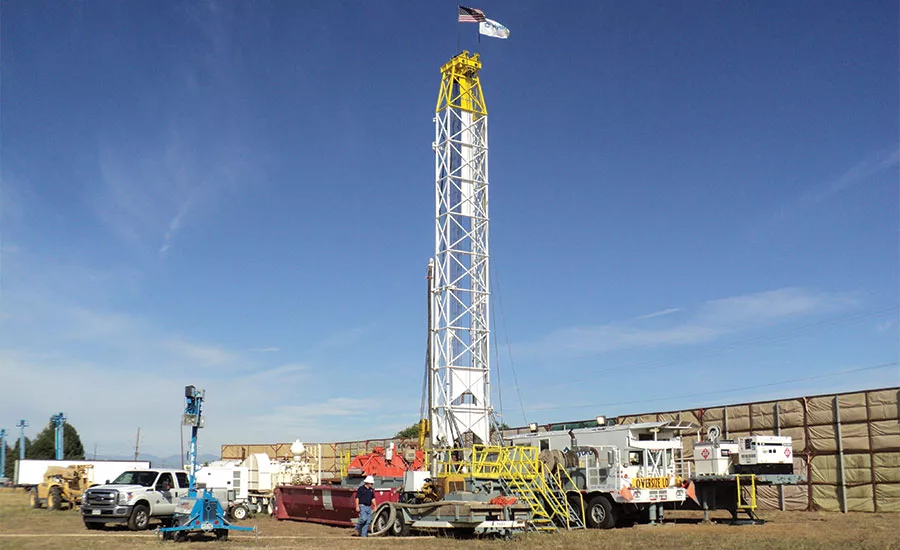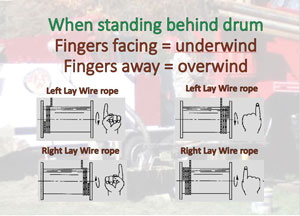Cores to Strands: More Basics on Wire Rope for Drillers

Wire rope gets used in all kinds of drilling applications. But how much do you really know about it?
Source: Hydro Resources / file
Early in my career as a driller, I thought I understood wire rope and its uses. I mean, what was there to understand? It seems simple: I pull the hoist lever and it winds up, if it is obviously damaged we replace it (when we have time), and if it is the right diameter it gets installed on the winch.
This changed after I took a class in crane operation one winter when work was slow. I found out why our winches did not always reave correctly. I learned how to determine if the rope we had was suited to the equipment. I learned that I really knew very little about wire rope. It is not the simplistic thing it appears to be. It is, in fact, a dynamic machine and, like all machines, requires a little knowledge to get optimal performance and safety.
Anatomy of a Wire Rope
A wire rope is a piece of flexible machinery made of many individual wires around a core made of fiber or wire. The core of a wire rope has a multitude of multiwire strands “laid” around it, forming a machine with individual moving parts that work together to provide strength and flexibility.
There are two general types of cores for wire rope depending on the desired properties for the finished product.
Fiber cores: Fiber core may consist of natural or synthetic fibers. Wire rope typically has a fiber core to provide greater flexibility at a given diameter. This increased flexibility often comes at the expense of tensile strength.
Wire core: Wire-core wire rope can come in two configurations: stranded core and independent-wire-rope core. Wire-strand core resists heat better than fiber core and can add 15 percent to the strength of the rope. However, wire rope using a wire-strand core will be less flexible than a fiber-core wire rope. An independent-wire-rope core is a separate wire rope over which the main strands of the rope are laid. This type of core strengthens the rope further and provides support against crushing. It offers greater resistance to heat, but further sacrifices flexibility. Most rope made for hoisting will be of the wire-core variety.
Beyond knowing the two basic types, fiber core and rope core, operators using wire rope will benefit from knowing a few basic terms, and how they apply.
Strands: A “strand” is a system of individual wires woven into a single structure. Multiple strands are placed, or “layed,” around the core of a wire rope. The lay of the rope affects the properties of the rope and the way the rope reeves onto a drum.
Lay: The “lay” of a wire rope describes the placement of the wires and strands. “Right lay” and “left lay” refer to the direction of strands. Right lay means that the strands pass from left to right across the rope. When the rope it tightened this will impart a counterclockwise rotation. Left lay will do just the opposite.
Also important is the way the wires are woven into each strand. “Regular lay” rope has wires woven in the opposite direction as the strand, so individual wires wind up running the same direction as the rope itself. “Lang lay” rope has wires woven in the same direction as the rope, so the wires wind up running across the length of the rope. Each configuration affects rope flexibility, resistance to wear and bending fatigue characteristics. Generally, regular lay ropes have good crushing resistance, and are less prone to kinks and birdcaging than lang lay ropes due to the relatively short length of exposed individual wires.
Lang lay is recommended for many excavating, construction and mining applications, including draglines, hoist lines, dredge lines and other similar lines. Here’s why: Lang lay ropes are more flexible than regular lay ropes. They also have greater wearing surface per wire. Where properly recommended, installed and used, lang lay ropes have many advantages over regular lay ropes. However, lang lay ropes are more susceptible to the abuses of bending over small-diameter sheaves, pinching in undersize sheave grooves, crushing when winding on drums, and failing due to excessive rotation. Left lang lay rope has greatest usage in oil fields on rod and tubing lines, blasthole rigs and spudders where the rotation of right lay rope would loosen couplings. The rotation of a left lay rope will tighten a standard right-hand tool joint.
Determining Rope Lay
So, how does a driller know if he is ordering the correct rope for the application? I learned a little trick to assist in deciding whether the rope for your winch should be a right or left lay, and it is so easy that after you hear it you most likely will not forget it.

Start by unwinding the winch until a single wrap remains. Next, make your hand into a fist and extend your index finger. While standing in front of the winch look at it. Is the rope coming off the front or back? What side is the remaining wrap on? Now, using your fist and index finger, emulate what you see. Your index finger is the rope and your fist is the drum of the winch. If the rope leaves the drum toward you on the left-hand side, you can only emulate that with your right hand. Therefore, a right-hand lay rope is required. However, if the rope leaves the drum from behind the drum on the left, your right hand cannot emulate this configuration but your left can. In that case, a left-lay rope would be necessary. Doing this will improve reeving of the winch, along with good practices like keeping weight on the cable and correctly installing the wire rope on the winch (which we will cover in the next installment of this series).
This basic stuff may seem a little slow moving in article form, but I know there are people out there like I was — who think that you just put a rope on and run it. These same people wonder why the winch doesn’t reeve right, or they replace or damage cables prematurely. This is a safety article, and I believe if you learn to use your tools correctly you will be safer.
Looking for a reprint of this article?
From high-res PDFs to custom plaques, order your copy today!





